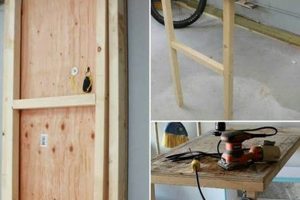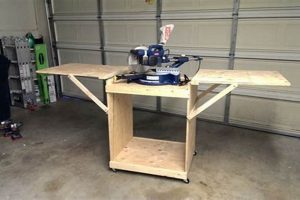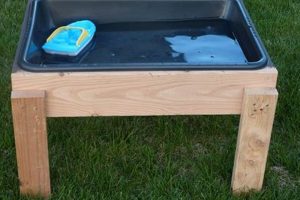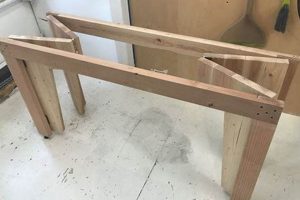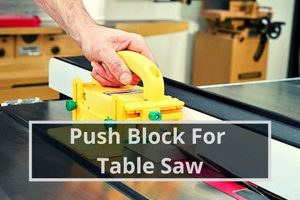A shop-built apparatus designed to enhance the capabilities and safety of a table saw is the focus. This construction typically involves a platform that slides within the saw’s miter slots, carrying the workpiece and allowing for precise, repeatable cuts. An example is a user constructing a platform from plywood, attaching runners that fit snugly in the miter slots, and adding a fence perpendicular to the blade’s path to ensure square cuts.
The value lies in improving cut accuracy and offering greater control over smaller or irregularly shaped pieces, thereby expanding the operational envelope of the table saw. Historically, these jigs have evolved from simple push sticks to more elaborate systems incorporating hold-downs, measuring scales, and even digital readouts, reflecting a continuous effort to refine woodworking techniques and safety practices.
Subsequent sections will address specific design considerations, material selection, construction techniques, and potential applications for this workshop addition. The discussion will further delve into advanced features and customization options, providing a detailed understanding of building and utilizing this valuable asset.
Essential Construction and Usage Guidelines
The following recommendations address critical aspects of building and employing a shop-made table saw accessory to ensure precision and safety.
Tip 1: Miter Slot Compatibility: Prioritize accurate measurement of the table saw’s miter slots before construction. The runners must fit snugly to minimize play and maximize cut precision. Use a digital caliper for accurate measurement and consider shimming if necessary.
Tip 2: Platform Material Selection: Employ high-quality plywood or medium-density fiberboard (MDF) for the platform. These materials offer dimensional stability and a smooth surface for the workpiece to glide upon. Avoid warped or cupped material.
Tip 3: Fence Alignment: Ensure the fence is perfectly perpendicular to the blade’s path. Utilize a precision square and clamping pressure to guarantee accurate alignment during assembly. Misalignment leads to inaccurate cuts.
Tip 4: Blade Clearance: Carefully plan the blade’s path to provide adequate clearance and prevent binding. Begin with a shallow cut and gradually increase the blade height as needed. Monitor the cut for any signs of friction.
Tip 5: Workpiece Securing: Implement clamping or toggle clamp systems to secure the workpiece firmly to the platform. This prevents movement during the cut and enhances both accuracy and safety. Test the clamping pressure before initiating the cut.
Tip 6: Runner Lubrication: Apply wax or dry lubricant to the runners to reduce friction and ensure smooth operation. This minimizes strain on the user and improves the overall cutting experience. Reapply lubricant periodically.
Tip 7: Gradual Testing: Prior to cutting valuable materials, test the functionality with scrap pieces. Check for squareness and ensure smooth operation before proceeding with critical projects.
Adhering to these guidelines promotes accurate and safe operation, maximizing the benefit derived from this shop-built auxiliary tool. Precise construction and attentive usage are paramount for achieving optimal results.
The subsequent section will discuss advanced applications and explore potential modifications for specialized tasks.
1. Accuracy
The degree of precision attainable in woodworking projects is often directly correlated with the accuracy of the tools employed. In the context of a shop-built table saw jig, accuracy is not merely a desirable trait but a fundamental requirement for achieving intended results.
- Miter Slot Runner Precision
The fit of the runners within the table saw’s miter slots directly influences the jig’s lateral movement and, consequently, the angle of the cut. Undersized runners introduce play, resulting in inaccurate cuts, while oversized runners cause binding and impede smooth operation. Precise measurement and fitting are crucial. For example, if the runners are off by even a millimeter, it can lead to noticeable angular deviations in the finished piece.
- Fence Squareness to Blade
The fence must be perfectly perpendicular to the blade. Any deviation from 90 degrees will introduce angular errors into the cut. The cumulative effect of even a slight misalignment becomes significant in longer cuts. An illustration would be attempting to create a perfectly square frame; if the fence is misaligned, the corners will not meet accurately.
- Measurement and Marking Techniques
Accuracy in measurement and marking is paramount during the jig’s construction. The use of precise measuring instruments, such as digital calipers and precision squares, is essential. Inaccurate marking translates directly into errors in the jig’s dimensions, affecting its overall performance. As an example, inaccurately measuring and marking the fence position would result in cuts that are consistently off by the same margin.
- Workpiece Securing Mechanisms
The method of securing the workpiece to the jig influences accuracy. If the workpiece shifts during the cut, the resulting dimensions will be inaccurate. Reliable clamping or other securing mechanisms are therefore essential for maintaining the workpiece’s position throughout the cutting process. Picture trying to cut a thin strip of wood; without proper securing, the wood could vibrate and move, creating a non-uniform cut.
These interconnected facets of accuracy underscore the importance of meticulous construction and careful operation. Neglecting any of these elements compromises the jig’s ability to produce precise cuts, ultimately diminishing its utility within the workshop. Prioritizing accuracy throughout the build and use process ensures the table saw jig serves as a valuable tool for achieving high-quality woodworking results.
2. Safety
The incorporation of a shop-built table saw jig significantly alters the operational dynamics and safety profile of the table saw. While enhancing precision and control, the introduction of this auxiliary tool necessitates a thorough understanding of associated safety considerations to mitigate potential hazards.
- Blade Exposure Reduction
A well-designed jig inherently reduces blade exposure compared to freehand operations. By encapsulating the workpiece and guiding it along a controlled path, the jig minimizes the likelihood of accidental contact with the blade. An example is cutting small or thin pieces, where the jig provides a stable platform, keeping hands away from the blade’s immediate vicinity. This reduction in exposure is a primary safety advantage.
- Kickback Mitigation
The guided movement enforced by the jig can significantly lessen the risk of kickback, a dangerous phenomenon where the workpiece is ejected violently back towards the operator. A properly constructed jig prevents the workpiece from twisting or binding against the blade, a common cause of kickback. For instance, when ripping narrow strips, the jigs fence and secure clamping mechanism maintain a straight path, preventing the wood from pinching the blade.
- Controlled Cutting Forces
The jig facilitates controlled application of force during the cutting process. By pushing the entire jig assembly rather than applying pressure directly to the workpiece, the operator maintains a more stable stance and reduces the potential for sudden, uncontrolled movements that could lead to injury. This is particularly relevant when working with dense or knotty wood, where uneven resistance can cause unexpected shifts.
- Dust and Debris Management
While not a direct safety feature of the jig itself, its use can indirectly improve dust and debris management. By providing a more controlled cutting environment, the jig allows for more effective dust collection systems to be employed. For example, enclosing the blade area within the jig’s structure can help to contain and direct dust towards a vacuum port, reducing inhalation hazards and improving visibility.
These facets illustrate that while a table saw sled offers significant benefits, it also necessitates a comprehensive safety-conscious approach. Correct jig design, proper usage, and adherence to established safety protocols are crucial for maximizing the tool’s advantages while minimizing potential risks.
3. Repeatability
The construction and utilization of a shop-built table saw sled are intrinsically linked to the concept of repeatability in woodworking. This capability to consistently produce identical cuts enhances efficiency, reduces material waste, and ensures dimensional accuracy across multiple components.
- Dimensional Consistency in Batch Production
The primary advantage of a well-designed table saw sled lies in its ability to produce multiple pieces of identical dimensions. This is particularly crucial when constructing furniture, cabinetry, or any project requiring numerous components with matching sizes. For example, creating drawer fronts or cabinet doors benefits significantly from the sled’s capacity to ensure each piece is cut to the exact same dimensions, eliminating variations that would otherwise necessitate individual adjustments. The consistent accuracy of the sled translates to a more refined final product.
- Angle Replication for Joinery
Many woodworking joints, such as miters and tenons, require precise angular cuts. A table saw sled equipped with an adjustable fence or indexing system allows for accurate replication of these angles across multiple pieces. For instance, constructing a multi-sided frame demands that each mitered corner be cut at precisely the same angle to ensure a seamless assembly. Without the repeatability offered by the sled, achieving this level of precision would be significantly more challenging and time-consuming.
- Minimizing Cumulative Error
In projects involving multiple cuts on the same piece, even small inaccuracies can accumulate, leading to significant errors in the final dimensions. A table saw sled, when properly calibrated, minimizes these cumulative errors by ensuring each cut is made with a high degree of accuracy. Consider a project requiring the creation of multiple identical grooves or dados. Without the precise control offered by the sled, slight variations in each cut can compound, resulting in a final piece that deviates significantly from the intended design.
- Streamlining Workflow and Reducing Waste
The repeatability afforded by a table saw sled streamlines the woodworking process by reducing the need for constant measurement and adjustment. This efficiency not only saves time but also minimizes material waste. When cuts are consistently accurate, there is less need to recut or discard pieces that do not meet the required dimensions. This is particularly important when working with expensive hardwoods or when adhering to strict material budgets. The consistent and accurate cuts leads to cost savings.
The facets detailed above demonstrate that repeatability is an integral benefit derived from the construction and use of a table saw sled. The inherent precision and stability offered by the jig contribute directly to enhanced accuracy, reduced waste, and streamlined workflow, making it an indispensable tool for woodworkers seeking consistently high-quality results. In conclusion it gives accuracy, safety, and save time.
4. Stability
The structural integrity of a shop-built table saw sled is directly linked to its operational effectiveness and user safety. Instability in the sled can manifest as vibrations, inconsistent cutting depths, and angular deviations, ultimately compromising the precision of woodworking tasks. The selection of materials, design of the base and runners, and joinery methods employed during construction all contribute to the overall stability of the apparatus. For instance, a sled constructed from thin, flexible plywood is prone to warping and flexing, leading to inaccurate cuts. In contrast, a sled utilizing thicker, denser materials like MDF or Baltic birch plywood provides a more stable platform.
Runner design significantly impacts lateral stability. Runners that do not fit snugly within the table saw’s miter slots introduce play, allowing the sled to shift during operation. This movement translates directly into inaccuracies, particularly when making fine or angled cuts. Precise measurement of the miter slots and careful shaping of the runners are crucial. Moreover, the connection between the runners and the sled’s base must be robust to prevent separation or loosening over time. Real-world examples include using epoxy and screws to secure the runners, ensuring a durable and stable connection that withstands the forces generated during cutting operations. The addition of reinforcing ribs or cross-braces beneath the sled’s base can further enhance its resistance to bending and twisting.
In summation, stability is a critical parameter governing the performance and safety of a table saw sled. Careful consideration of material selection, runner design, and joinery techniques is paramount in achieving a stable and reliable platform for precision woodworking. Addressing potential instabilities through meticulous construction practices minimizes the risk of inaccuracies and ensures consistent results. The pursuit of a stable sled is not merely a matter of convenience, but a fundamental requirement for safe and accurate operation of a table saw.
5. Adjustability
The capacity for modification is a defining characteristic of shop-built woodworking jigs, significantly enhancing their utility and adaptability to diverse project requirements. Adjustability, in the context of a shop-made table saw auxiliary tool, refers to the range of alterations possible to accommodate varying workpiece sizes, angles, and cutting depths.
- Fence Positioning for Variable Width Cuts
The lateral positioning of the fence is a primary aspect of adjustability. This allows for precise control over the width of the material being cut, accommodating both narrow and wide stock. A fence that can be easily repositioned and securely locked down enables the creation of consistently sized components for projects such as drawer boxes or picture frames. Inadequate adjustability restricts the range of workpiece sizes that can be processed, limiting the jig’s overall utility.
- Angle Adjustment for Mitered Cuts
The ability to alter the angle of the fence facilitates the creation of accurate mitered cuts, essential for constructing frames, boxes, and other polygonal shapes. An adjustable fence, often incorporating a protractor scale or detents for common angles, simplifies the process of cutting precise miters. The absence of such adjustability necessitates the use of separate jigs or complex calculations to achieve accurate angles. Consider the task of building a picture frame: adjustability ensures all corners meet at the correct angle for a seamless fit.
- Blade Height Control and Depth Adjustment
The height of the saw blade relative to the jig’s surface is another critical element of adjustability. This parameter dictates the depth of the cut and is particularly relevant when creating dados, grooves, or rabbets. A table saw jig that accommodates variable blade heights allows for the execution of diverse joinery techniques. For example, cutting a precisely sized dado for a shelf requires the ability to adjust the blade height to the exact desired depth.
- Incorporation of Stop Blocks and Measuring Scales
The addition of adjustable stop blocks and integrated measuring scales enhances the jig’s repeatability and precision. Stop blocks provide a physical limit for the workpiece, ensuring consistent lengths in repetitive cuts. Measuring scales facilitate precise positioning of the workpiece relative to the blade, eliminating the need for manual measurement. These features contribute to greater efficiency and accuracy in production runs.
The various forms of adjustability discussed above highlight the importance of incorporating flexible design elements into shop-built table saw auxiliary tools. A well-designed table saw sled prioritizes ease of modification to accommodate evolving project needs, enhancing its versatility and value within the woodworking shop. It can be designed to adjust to the required dimensions or angles, rather than be a tool that can only be used for certain angles or cutting requirements.
6. Material Choice
The selection of materials for a shop-built table saw sled directly impacts its performance, accuracy, and longevity. The cause-and-effect relationship is evident: suboptimal material choice results in diminished precision and reduced operational lifespan, while judicious selection yields a stable, accurate, and durable jig. High-quality materials, such as Baltic birch plywood or medium-density fiberboard (MDF), possess inherent dimensional stability, resisting warping and expansion or contraction due to environmental changes. This stability is paramount in maintaining the fence’s perpendicularity to the blade and ensuring consistent cut dimensions. Conversely, lower-grade plywood with voids or inconsistencies introduces inherent weaknesses, potentially leading to structural failure or inaccurate cuts. The presence of voids affects the integrity of the structure. Consider an instance where a miter sled constructed with subpar plywood exhibits flexing under pressure; this flexing translates directly to inaccurate miter cuts, rendering the jig unsuitable for precision work. Consequently, material choice is not merely a superficial consideration but a fundamental determinant of the jig’s overall effectiveness.
Practical application dictates a careful evaluation of material properties in relation to the sled’s intended use. A jig primarily intended for cutting small, lightweight pieces may tolerate less robust materials. However, a sled designed for processing large, heavy stock necessitates the selection of high-density, dimensionally stable materials capable of withstanding significant stress. Runners are a prime example: hardwoods or phenolic laminates offer superior wear resistance compared to softer woods, ensuring smooth and consistent operation within the table saw’s miter slots over extended periods. Similarly, the fastening methods employed must be compatible with the chosen materials to ensure secure and lasting connections. For instance, using screws in MDF requires careful pilot hole preparation to prevent splitting or stripping. Careful material choices will help in the long run.
In summary, material choice for a table saw sled is a critical consideration influencing accuracy, stability, and longevity. The selection process should prioritize dimensionally stable materials capable of withstanding anticipated stresses and environmental conditions. Challenges arise when balancing cost considerations with performance requirements. While high-quality materials represent a greater initial investment, the resulting improvements in accuracy and durability often outweigh the expense in the long term. Prioritizing informed material selection ensures that a shop-built jig serves as a reliable and valuable asset in the woodworking shop, thereby promoting efficiency and high-quality outputs.
7. Construction Methods
The methods employed in the creation of a shop-built table saw sled are fundamental determinants of its precision, durability, and operational safety. Suboptimal construction techniques compromise these factors, whereas meticulous execution results in a reliable and accurate woodworking aid.
- Joinery Selection and Execution
The choice of joinery significantly impacts the structural integrity of the table saw sled. Basic butt joints, while simple to execute, offer limited strength and resistance to racking forces. Alternatives such as rabbet joints, dado joints, or mortise-and-tenon joints provide superior mechanical strength and dimensional stability. For example, a sled utilizing rabbet joints to connect the base to the fence offers greater resistance to misalignment compared to one using solely butt joints. The precise execution of these joints, ensuring tight fits and proper adhesive application, is critical for long-term performance. The method should be appropriate and long lasting.
- Runner Attachment and Alignment
The method of attaching the runners to the sled base directly influences its smooth operation and accuracy. Screws alone may not provide sufficient holding power, particularly in softer materials. Embedding runners within dadoes or using epoxy in conjunction with screws provides a more secure and stable connection. Furthermore, precise alignment of the runners with the sled base is paramount. Misaligned runners cause binding or excessive play within the table saw’s miter slots, resulting in inaccurate cuts. Precision measurement and careful clamping during runner attachment are essential. Runnel attachment must be done accurately.
- Fence Construction and Perpendicularity
The construction of the fence must prioritize rigidity and dimensional stability to ensure consistent perpendicularity to the blade. Using laminated construction or incorporating internal bracing can significantly enhance fence stiffness. The method used to attach the fence to the sled base must also maintain this perpendicularity under load. Screws, bolts, or dowels in combination with adhesive can provide a secure and stable connection. Regularly checking and adjusting the fence’s perpendicularity is essential for maintaining accuracy. The construction method has to be rigid.
- Surface Finishing and Friction Reduction
The application of a smooth, durable finish to the sled’s surface reduces friction and facilitates smooth workpiece movement. Applying multiple coats of varnish or lacquer, followed by sanding and waxing, creates a low-friction surface that minimizes resistance during cutting operations. Furthermore, lubricating the miter slots and runners with wax or dry lubricant further reduces friction and ensures smooth travel. Reduced friction enhances both accuracy and ease of use. A finishing touches can improve functionality
The construction methods employed in building a table saw sled collectively determine its functionality and longevity. Prioritizing robust joinery, accurate runner alignment, rigid fence construction, and surface finishing techniques ensures that the jig provides reliable and accurate performance over an extended period, maximizing its value in the woodworking shop.
Frequently Asked Questions
The following section addresses common inquiries regarding the construction and utilization of table saw sleds, clarifying design considerations and operational best practices.
Question 1: What constitutes a suitable material for sled construction, balancing cost and performance?
Medium-density fiberboard (MDF) offers a blend of dimensional stability and affordability, serving as a viable option for the sled’s base. Hardwood runners, while potentially more expensive, provide superior wear resistance within the saw’s miter slots.
Question 2: How does one ensure the fence remains perfectly perpendicular to the blade, and what are the consequences of misalignment?
Employing a precision square during fence attachment is paramount. Misalignment introduces angular inaccuracies in cuts, particularly noticeable in joinery requiring precise angles, such as mitered corners.
Question 3: What safety precautions are particularly important when operating a shop-built sled?
Secure workpiece clamping is crucial to prevent movement during the cut. Furthermore, maintaining control of the sled throughout its travel and avoiding overreach are essential practices.
Question 4: How can the sled be optimized for small or irregularly shaped workpieces?
Incorporating adjustable clamps or hold-downs provides secure workpiece retention. Custom-fitted supports accommodate irregular shapes, preventing movement and ensuring accurate cuts.
Question 5: What are the recommended methods for minimizing friction between the runners and miter slots?
Application of paste wax or dry lubricant to the runners reduces friction, promoting smooth sled movement. Ensuring the runners fit snugly, without binding, is also critical.
Question 6: How does one address potential tear-out when cutting across the grain, and what techniques mitigate this issue?
Employing a zero-clearance insert minimizes tear-out by supporting the wood fibers immediately adjacent to the blade. Scoring the cut line prior to making the primary cut can also reduce splintering.
The preceding questions and answers provide a foundation for understanding key considerations in the construction and operation of shop-built table saw jigs. Attention to these details enhances the precision, safety, and overall effectiveness of the apparatus.
The following section will explore advanced modifications and customized applications, building upon the foundational knowledge presented herein.
DIY Table Saw Sled
The preceding exploration has illuminated the multifaceted nature of the diy table saw sled. From material selection and construction techniques to safety protocols and advanced applications, each element contributes to the tool’s efficacy in enhancing table saw operations. Dimensional stability, precise alignment, and secure workpiece clamping are foundational to achieving accurate and repeatable cuts, maximizing the benefits derived from this shop-built apparatus.
As woodworking practices evolve, the principles outlined herein serve as a benchmark for constructing and utilizing a versatile and reliable diy table saw sled. Continued refinement of design and technique, coupled with a steadfast commitment to safety, will ensure its continued relevance in the pursuit of precision and efficiency within the modern woodworking environment. The diligent application of these principles translates directly into tangible improvements in project quality and operational safety.


